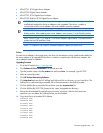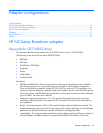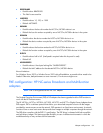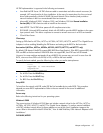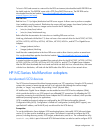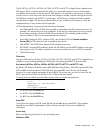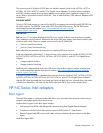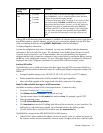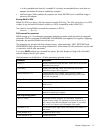
Adapter configurations 67
protocol. See the Microsoft website (http://www.microsoft.com) to download the Microsoft iSCSI
Software Initiator installation wizard software and to obtain installation and usage information.
The accelerating iSCSI feature comes standard with standup HP Multifunction Server Adapters.
Accelerating iSCSI capabilities are available for embedded HP Multifunction Gigabit Server Adapters
through the purchase and installation of an HP ProLiant Essentials Accelerated iSCSI Pack license
("Accelerated iSCSI for embedded HP Multifunction server adapters" on page 153).
Configuring advanced settings parameters
If iSCSI is enabled on a Multifunction adapter port, you can adjust the SRB (iSCSI Request Block) Timeout
Delta setting and create an iSCSI VLAN for the adapter. Increasing this value may help prevent I/O
timeouts if your network is highly congested and packets are being dropped frequently.
iSCSI adapter information includes the following:
o Current MAC Address. The current MAC address for the iSCSI device.
o iSCSI Driver Name. The name of the driver for the iSCSI device
o iSCSI Driver Version. The version of the driver for the iSCSI device.
o Default Gateway. The default route for the iSCSI device.
o Subnet Mask. The subnet mask (dotted decimal) for the iSCSI device.
o iSCSI VLAN Id. The identification number (if any) for the virtual iSCSI VLAN device.
o iSCSI Packet Priority. The packet priority for the iSCSI device.
o SRB Timeout Delta. The increase to the timeout value for I/O operations.
o Page File Created. Indicates whether or not the Windows page file was created on an iSCSI
drive that is attached to the adapter. The values are Yes and No.
o DHCP (Dynamic Host Configuration Protocol). Enabled indicates that DHCP is used to acquire IP
configuration; Disabled indicates that the statically configured IP configuration is used.
o IP Address. The IPv4 address (dotted decimal) for the iSCSI device.
iSCSI boot configuration: Multifunction adapters
HP iSCSI boot is currently supported on Linux operating systems only.
The HP iSCSI boot feature allows you to boot from a remote disk (known as the iSCSI target) on a Storage
Area Network (SAN) without having to directly attach a boot disk.
Booting from a remote disk on a SAN allows you to centralize the boot process and consolidate
equipment resources. Unlike other implementations, iSCSI boot does not require a separate DHCP server
or a PXE server.
For more information about HP iSCSI Boot refer to the HP iSCSI Boot for Linux User Guide.
PXE configuration: HP NC-series Broadcom and Multifunction
adapters
NOTE: PXE is not supported on the NC150T adapter.
The Pre-boot Execution Environment (PXE) of HP adapters has been upgraded to allow PXE functions to
work with the HP ProLiant servers.




